Viavi Solutions 5882TWB Handheld Network Tester User Manual MS Word
Viavi Solutions Inc. Handheld Network Tester MS Word
Contents
- 1. User Manual - GettingStarted
- 2. User Manual - SafetyInstructions
User Manual - SafetyInstructions

Safety Instructions: T-BERD/MTS 5800 Family, SC 4800 Family and TEM
2 March 2018 21148865, Rev 006 Page 1
Safety Instructions
T-BERD ⁄ MTS 5800 and SC 4800 Families
and TEM
Important: read these instructions before connecting a module or components to a base unit!
These instructions provide safety information for the T-BERD ⁄ MTS 5800 (v1, v2, 100G, 5882 and the
accessories, 5800-TOD and 5800-EPP ), SC 4800 (Smart Class 4800/4800P) and the TEM (Timing
Expansion Module).
Topics covered in these instructions include:
• Important safety instructions
• Consignes de sécurité importantes
• Wichtige Sicherheitsinformationen
• Importanti istruzioni di sicurezza
• Instrucciones de seguridad
• Safety classifications and standards
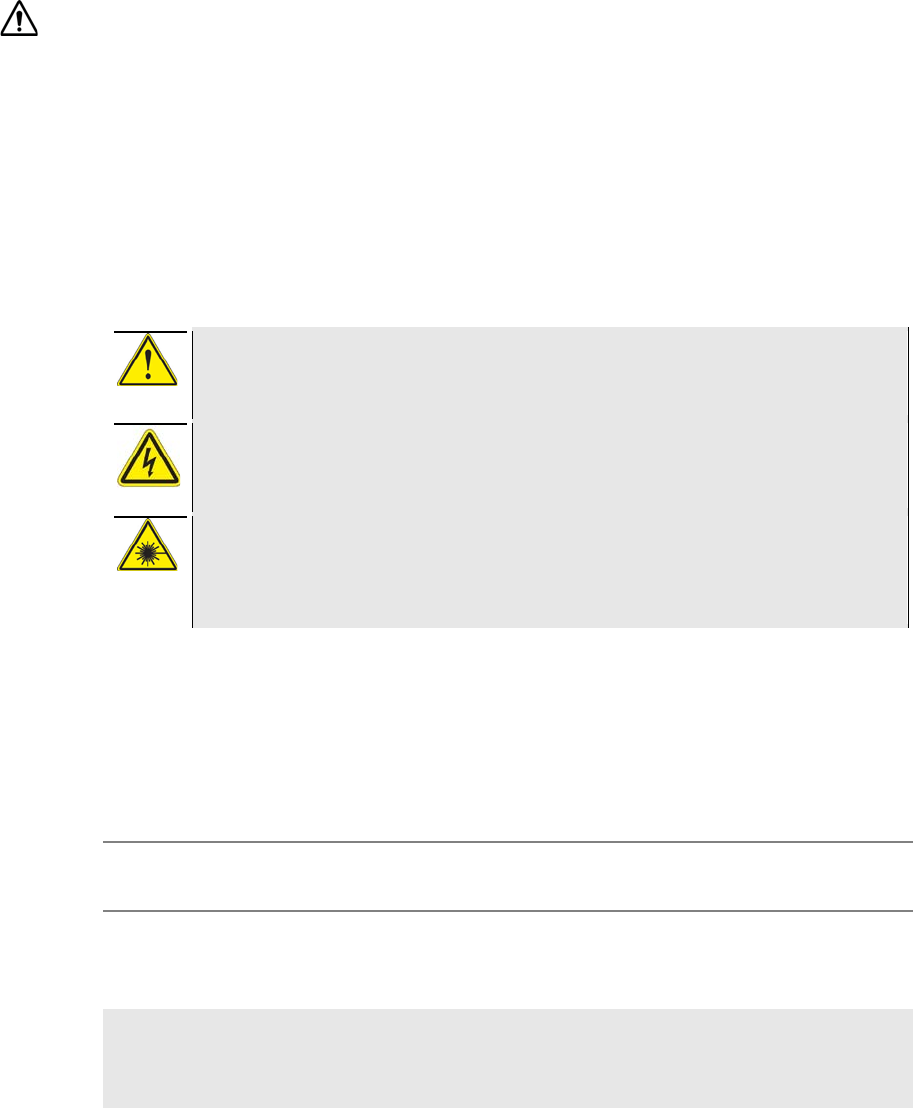
Important Safety Instructions
Safety Instructions: T-BERD/MTS 5800 Family, SC 4800 Family and TEM
2 March 2018 21148865, Rev 006 Page 2
Important Safety Instructions
These instructions provide an explanation of safety symbols, definitions for safety terms, and precautions
you should follow when using the T-BERD ⁄ MTS 5800, SC 4800, and TEM.
Safety symbols
The following safety symbols are used on the instruments supported by these instructions. All safety
precautions must be observed when operating, servicing, or repairing the instruments. Failure to comply
with the following safety precautions or with dangers, warnings and cautions used throughout this
document or related manuals violates the intended use of this instrument.
This symbol represents a general hazard. It may be associated with a DANGER,
WARNING, or CAUTION message. See Table 1 for more information.
This symbol represents hazardous voltages. It may be associated with a DANGER,
WARNING, or CAUTION message. See Table 1 for more information.
This symbol represents a risk associated with fiber optic lasers. It may be associated
with a DANGER, WARNING, or CAUTION message. See Table 1 for more infor-
mation.
Safety terms
Table 1 defines safety terms used in the product documentation. Failure to observe these precautions
while using the instruments violates the intended use of the products.
Table 1 Safety term definitions
Term Definition
DANGER Indicates a potentially hazardous situation that, if not avoided, will result in
death or serious injury. It may be associated with either a general hazard,
high voltage, or risk of explosion symbol.
WARNING Indicates a potentially hazardous situation that, if not avoided, could result in
death or serious injury. It may be associated with either a general hazard,
high voltage, or risk of explosion symbol.
CAUTION Indicates a potentially hazardous situation that, if not avoided, could result in
minor or moderate injury and/or damage to equipment. It may be associated
with either a general hazard, high voltage, or risk of explosion symbol.
Important Safety Instructions
Safety Instructions: T-BERD/MTS 5800 Family, SC 4800 Family and TEM
2 March 2018 21148865, Rev 006 Page 3
The instruments supported by these instructions are designed to be used to test non-hazardous circuits
with voltages less than 42.4 V peak and 60 VDC.
You must be responsible for your own safety by employing proper safety procedures to minimize the risk of
electrical shock. Comprehensive safety training is beyond the scope of these instructions. Still, you should
read and understand all safety information within before using these products.
When using the product, basic safety precautions should always be followed to reduce the risk of fire,
shock, and injury to persons, including the following:
1. Read and follow all warning notices and instructions marked on the product and included in the
manual.
2. CAUTION: If the equipment is used in a manner not specified by Viavi, the protection provided by
the equipment may be impaired.
3. Use only the AC Adapter/Charger and main cords supplied with the product. Do not use AC
Adapter/ Charger outdoors or in wet or damp locations. Connect the AC Adapter/Charger to the
correct mains voltage as indicated on the ratings label.
4. Do not allow anything to rest on the power cord, and do not locate the product where persons can
walk on the power cord.
5. This product is intended to be used with a 3-wire grounding-type plug (a plug that has a grounding
pin). This safety feature is vital to the safe operation of the instrument. Do not defeat the purpose of
the grounding-type by modifying the plug or using an adapter.
6. Do not use telephone equipment (other than cordless) during a lightning storm. There is a
possibility of a nearby lightning strike, which could exceed the capacity of the telephone network
protective devices and harm you.
7. Do not use telephone equipment in the vicinity of a gas leak or in any explosive environment. This
tester, and most other telephone equipment, could in normal operation generate a spark strong
enough to ignite a fire or explosion.
8. Do not touch or otherwise come in contact with telephone conductors that could be exposed to
lightning or accidental connection to power circuits without first isolating them from the telephone
network.
9. Do not install telephone equipment or terminations (jacks) in wet locations unless the equipment or
termination is specifically designed for such locations.
10. Do not cause or allow telephone or telecommunication circuits to come in contact with power
circuits (mains).
11. Do not attempt to service this product yourself, as opening or removing covers may expose you to
dangerous high voltage points and other hazards. Refer all servicing to qualified service personnel.
12. The T-BERD/MTS 5800 and SC 4800 families of devices comply with FCC and Industry Canada
RF exposure limits set forth for an uncontrolled environment. For body worn operation, the
instruments meet the FCC RF exposure limits when used with an accessory that contains no metal
and that positions the instrument a minimum of 0cm from the body. CAUTION: This transmitter
must not be co-located or operating in conjunction with any other antenna or transmitter.
13. Use appropriate cables when connecting to telecommunications circuits. Putting an RJ-11
connector in a RJ-45 port can damage the RJ45 port.
Important Safety Instructions
Safety Instructions: T-BERD/MTS 5800 Family, SC 4800 Family and TEM
2 March 2018 21148865, Rev 006 Page 4
14. WARNING: Danger of extreme heat, fire, or explosion if battery is tampered with. Replace only with
Viavi approved Li-ION battery. Dispose of used batteries according to the manufacturer's
instructions.
15. WARNING: Charge the lithium ion battery using only the Viavi instrument or approved battery
charger. The battery is to be used only with Viavi test products.
16. Only trained telecommunications technicians who understand the hazards associated with TNV
lines and practice proper procedures for dealing with TNV should use this tester.
17. Be sure that TNV signals are not connected to SELV ports. If you need to access a line that may
have TNV or higher voltages present using a SELV port, you must do so through an interface
device that is certified to provide a SELV connection point.
18. PoE-compatible interfaces that are classified as SELV are not intended for connection to PoE
networks with routing to the outside plant.
19. CAUTION: When equipped with laser modules supplied by Viavi, this instrument will be a CLASS 1
LASER PRODUCT. Class 1 lasers can cause dazzle, flash-blindness, and afterimages. Avoid
looking into laser output while performing safety critical operations, such as climbing on a ladder or
operating machinery. Do not use laser modules of other classes.
20. Please see “Safety symbols” for safety symbols. Where the unit is labeled with a warning symbol,
the operating manual must be consulted to learn more about the nature of the potential hazard and
any action that must be taken.
Save these instructions
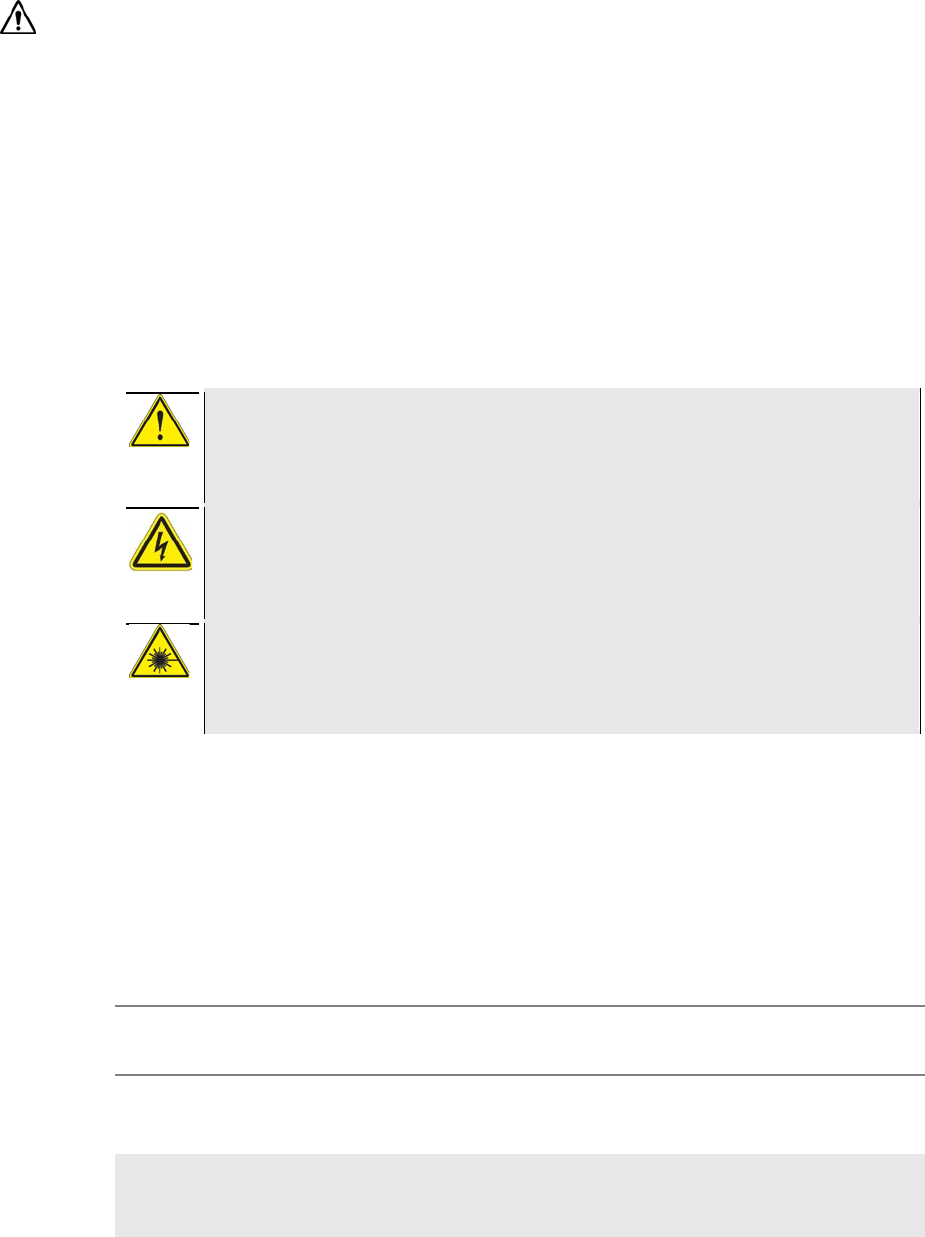
Consignes de sécurité importantes
Safety Instructions: T-BERD/MTS 5800 Family, SC 4800 Family and TEM
2 March 2018 21148865, Rev 006 Page 5
Consignes de sécurité importantes
Ce livret contient des définitions de termes et des consignes de sécurité que nous vous conseillons de
respecter lorsque vous utilisez votre appareil des familles de produits T-BERD ⁄ MTS 5800 et SC 4800, et
le TEM.
Symboles de sécurité
Les symboles de sécurité suivants sont utilisés sur les instruments pris en charge par ces instructions.
Toutes les précautions doivent être observées lors de l'exploitation, d'entretien ou de réparation des
instruments. Omission de se conformer aux consignes de sécurité suivantes ou à risques, les dangers, les
avertissements et les mises en garde utilisés tout au long de ce document ou manuels connexes viole
l'usage de cet instrument.
Ce symbole représente un danger général. Il peut être associé à un message
DANGER, ATTENTION, ou PRUDENCE. Voir les conditions de sécurité pour plus d'in-
formations.
Ce symbole représente des tensions dangereuses. Il peut être associé à un message
DANGER, ATTENTION, ou PRUDENCE. Voir les conditions de sécurité pour plus d'in-
formations.
Ce symbole représente un risque associé de lasers à fibre optique. Il peut être associé
à un message DANGER, ATTENTION, ou PRUDENCE. Voir les conditions de sécurité
pour plus d'informations.
Terminologie liée à la sécurité
Le Tableau 2 définit les termes de sécurité utilisés dans la documentation du produit. Non respect de ces
précautions tout en utilisant les instruments viole l'utilisation prévue des produits.
Tableau 2 Terminologie liée à la sécurité
Terme
Definition
DANGER Indique une situation présentant un danger immédiat qui, si elle n’est pas
évitée, engendrera des blessures graves ou mortelles.
ATTENTION
Indique une situation présentant un danger potentiel qui, si elle n’est pas
évitée, peut engendrer des blessures graves ou mor- telles.
Consignes de sécurité importantes
Safety Instructions: T-BERD/MTS 5800 Family, SC 4800 Family and TEM
2 March 2018 21148865, Rev 006 Page 6
Tableau 2 Terminologie liée à la sécurité
PRUDENCE
Indique une situation présentant un danger potentiel qui, si elle n’est pas
évitée, pourrait engendrer des blessures mineures ou légères, ou une dété-
rioration de l’appareil.
Les instruments pris en charge par ces directives sont conçues pour servir à tester les circuits non
dangereux avec des tensions moins de 42,4 V crête et 60 VDC.
Les lignes extérieures peuvent véhiculer des tensions dangereuses engendrées par la foudre ou un
raccordement accidentel à des circuits d’alimentation électrique. Ce type de ligne est classé dans la
catégorie des lignes à tension de réseau de télécommunication (TNV). Les fournisseurs de services de
télécommunication appliquent toutes les mesures de protection appropriées afin de limiter les surtensions
électriques dangereuses sur les lignes TNV. Cependant, il est impossible de réaliser une protection
absolue contre les dangers TNV. Vous pourriez gravement vous blesser si vous ne maîtrisez pas les
dangers TNV, notamment ceux liés à la foudre et au raccordement accidentel de circuits d’alimen- tation
électrique. Vous êtes le seul responsable de votre propre sécurité. Par conséquent, appliquez des
procédures de sécurité correctes afin de minimiser le risque d’électrocution. Le présent livret n’ayant pas
pour objectif de dispenser une formation étendue sur la sécu- rité TNV, lisez attentivement toutes les
consignes de sécurité et veillez à les appliquer correctement avant d’utiliser ce produit.
Lorsque vous utilisez ce produit, plusieurs consignes de sécurité primaires doivent toujours être
appliquées afin de réduire le risque d’incendie, de décharge électrique et de blessure corporelle :
1. Lisez attentivement et respectez tous les avertissements et toutes les instructions figurant sur le
produit et dans sa notice.
2. PRUDENCE : Si cet équipement est utilisé d’une manière non recommandée par Viavi, la
protection intrinsèque pourra être mise en défaut.
3. Utilisez uniquement l’adaptateur/chargeur CA et les câbles livrés avec le produit. N’utilisez pas cet
accessoire à l’extérieur ou dans des locaux humides. Raccordez-le à la tension de ligne CA
correcte, conformément aux indications de l’étiquette signalétique.
4. Ne posez pas d’objet sur le cordon d’alimentation et évitez de placer le produit dans des endroits à
fort passage.
5. Ce produit est conçu pour être utilisé avec une prise équipée de la terre (trois fils). Cette sécurité
est indispensable pour une utilisation sans danger de l’appareil. Ne pas supprimer cette sécurité en
modifiant la prise ou en utilisant un adaptateur.
6. N’utilisez pas l’équipement téléphonique (autres que sans fil) pendant un orage car il existe un
risque de coup de foudre qui pourrait dépasser la capacité des dispositifs de protection du réseau
téléphonique et vous blesser.
7. N’utilisez pas de téléphone à proximité d’une fuite de gaz ou dans un environnement explosif car
en fonctionnement normal, ce testeur pourrait, ainsi que la plupart des équipements téléphoniques,
produire une étincelle qui suffirait à déclencher un incendie ou une explosion.
8. Ne touchez pas ou n’entrez pas en contact avec des conducteurs téléphoniques susceptibles d’être
exposés à la foudre ou à un raccordement accidentel à des circuits d’alimentation électrique, sans
les avoir préalablement isolés du réseau téléphonique.
Consignes de sécurité importantes
Safety Instructions: T-BERD/MTS 5800 Family, SC 4800 Family and TEM
2 March 2018 21148865, Rev 006 Page 7
9. N’installez pas l’équipement téléphonique ou ses connecteurs dans des endroits humides, sauf si
ceux-ci ont été spécifiquement conçus pour des environnements de ce type.
10. Ne faites pas contacter ou ne laissez pas le téléphone ou les circuits de télécommunication des
circuits de puissance (secteur).
11. Ne tentez pas de réparer ce produit par vos propres moyens car l’ouverture ou le retrait de
couvercles peut vous exposer à des points de haute tension dangereux et à d’autres risques. Pour
toute réparation, faites appel à un spécialiste qualifié.
12. Les instruments T-BERD / MTS-5800 (v1, v2, 100G, 5882) et SC 4800/4800P se conforment avec
les limites d'exposition RF Industry Canada et FCC pour un environnement non contrôlé. Pour des
opérations avec l'appareil porté sur corps, les instruments respectent les limites d'exposition RF
FCC quand ils sont utilisés avec un accessoire qui ne contient pas de métal et qui positionne
l'appareil à une distance minimale de 0 cm du corps. ATTENTION: Ce transmetteur ne doit pas
être colocalisé ou utilisé en conjonction avec un autre transmetteur ou une autre antenne.
13. Employez les câbles appropriés en se reliant aux circuits de télécommunications. La mise d'un
connecteur RJ-11 dans un port RJ-45 peut endommager le port RJ45.
14. ATTENTION : Si vous tentez d’ouvrir la batterie, une situation dangereuse peut appa raître
(dégagement de chaleur extrême, incendie ou explosion). Remplacez seulement par la batterie de
Li-ION approuvée par Viavi. Eliminez les batteries usagées conformément aux instructions fournies
par le fabricant.
15. ATTENTION :Chargez une batterie de type lithium-ion en utilisant uniquement le chargeur Viavi ou
instrument Viavi fournis. Cette batterie doit être exclusivement utilisée avec les produits Viavi.
16. Ce testeur doit uniquement être utilisé par des techniciens en télécommunication qualifiés,
conscients des risques liés aux lignes TNV et appliquant les procédures correctes pour les tensions
TNV.
17. Vérifiez qu’aucun signal TNV n’est transmis aux ports SELV. Si vous devez accéder à une ligne
susceptible de véhiculer une tension TNV ou supérieure en utilisant un port SELV, vous devez
intercaler un équipement d’interface certifié pour fournir un point de raccordement SELV.
18. Les interfaces compatibles PoE classées SELV ne sont pas destinées à la connexion aux réseaux
PoE avec routage vers l'installation externe.
19. PRUDENCE : Quand cet instrument est équipé de modules laser fournis par Viavi, il devient
PRODUIT DE LASER DE LA CLASSE 1. Les lasers de la classe 1 peuvent provoquer dazzle,
flash-cécité et rétinienne. Éviter de regarder en sortie laser tout en effectuant des opérations
critiques de sécurité, tels que grimper sur une échelle ou d'opérer de la machinerie. N'utilisez pas
de modules laser d'autres classes.
20. Veuillez voir les “Safety symbols” pour des symboles de sûreté. Là où l'unité est marquée avec un
symbole d'avertissement, le operating manual doit être consulté pour apprendre plus au sujet de la
nature du risque et de n'importe quelle mesure qui doivent être pris.
Mémorisez ces instructions
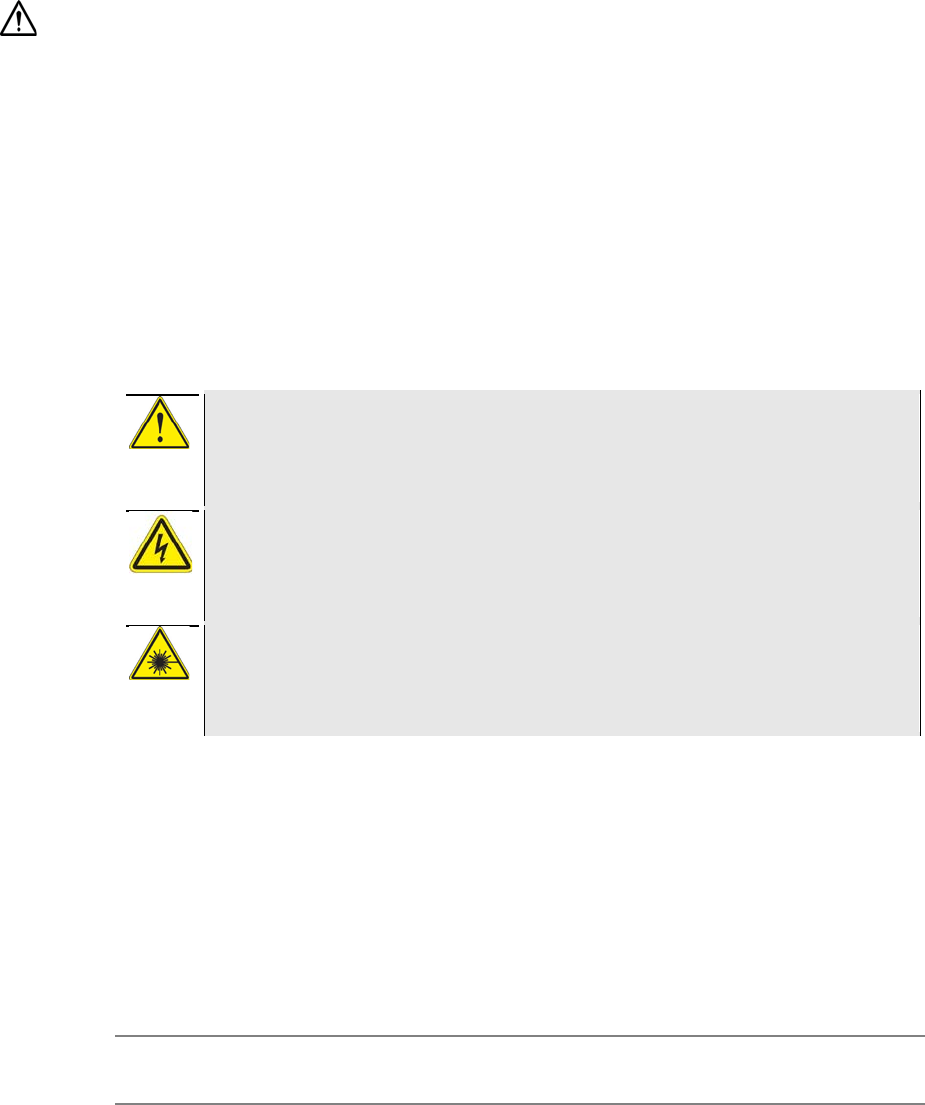
Wichtige Sicherheitsinformationen
Safety Instructions: T-BERD/MTS 5800 Family, SC 4800 Family and TEM
2 March 2018 21148865, Rev 006 Page 8
Wichtige Sicherheitsinformationen
Diese Anweisungen enthalten eine Erklärung der Sicherheitssymbole, Definitionen für Begriffe Sicherheit
und Vorkehrungen, die Sie befolgen sollten, wenn Sie verwenden die T BERD ⁄ MTS-5800 Produktfamilie,
SC 4800 Produktfamilie, und die TEM.
Sicherheitssymbole
Zu den Instrumenten, die von diesen Anweisungen unterstützt werden die folgenden Sicherheitssymbole
verwendet. Alle Sicherheitsvorkehrungen müssen beachtet werden, beim Betrieb, Wartung oder Reparatur
der Instrumente. Die Nichteinhaltung mit die folgenden Sicherheitsvorkehrungen oder Gefahren,
Gefahrenhinweise verwendet in diesem Dokument oder Verwandte Handbücher verstößt gegen die
beabsichtigte Verwendung dieses Instruments.
Dieses Symbol stellt eine allgemeine Gefahr dar. Es kann eine GEFAHR, WARNUNG
oder VORSICHT Nachricht zugeordnet werden. Finden Sie unter Sicherheit Begriffe für
weitere Informationen.
Symbol für gefährlichen Spannungen. Es kann eine GEFAHR, WARNUNG oder VOR-
SICHT Nachricht zugeordnet werden. Finden Sie unter Sicherheit Begriffe für weitere
Informationen.
Dieses Symbol stellt ein Risiko im Zusammenhang mit Faserlaser-Optik. Es kann eine
GEFAHR, WARNUNG oder VORSICHT Nachricht zugeordnet werden. Finden Sie un-
ter Sicherheit Begriffe für weitere Informationen.
Definition der Sicherheitshinweise
Tabella 4 definiert die in der Produktdokumentation enthaltenen Sicherheitshinweise. Bei Nichtbeachtung
dieser Vorsichtsmaßnahmen beim Einsatz der Instrumente verstößt gegen die beabsichtigte Verwendung
der Produkte.
Tabelle 3 Definition der Sicherheitshinweise
Begriff
Beschreibung
GEFAHR Zeigt eine unmittelbar gefährliche Situation an, die bei Nichtbeach- tung zu
schweren Verletzungen oder zum Tod führt.

Wichtige Sicherheitsinformationen
Safety Instructions: T-BERD/MTS 5800 Family, SC 4800 Family and TEM
2 March 2018 21148865, Rev 006 Page 9
WARNUNG Signalisiert eine potenziell gefährliche Situation, die bei Nichtbeach- tung zu
schweren Verletzungen oder zum Tod führen könnte.
VORSICHT Informiert über eine potenziell gefährliche Situation, die bei Nicht- beachtung
zu leichten oder mittleren Verletzungen oder zu einem Geräteschaden füh-
ren könnte.
Die Instrumente, die von diesen Anweisungen unterstützt sollen verwendet werden, zu ungefΣhrlich
Schaltungen mit Spannungen kleiner als 42,4 V Spitze und 60 VDC zu testen.
Durch Blitzeinschlag oder versehentlichen Anschluss an Hochspannungsleitungen können an Außenlei-
tungen, die als TNV-Leitungen (Telecommunications Network Voltage) für den Anschluss an Telekommu-
nikationsleitungen vorgesehen sind, gefährliche Spannungen anliegen. Die Telekommunikationsanbieter
ergreifen alle angemessenen Schutzmaßnahmen zur Begrenzung gefährlicher Spannungsspitzen auf
TNV-Leitungen. Ein vollständiger Schutz vor Überspannungen ist jedoch nicht möglich. Die Nichtbeach-
tung der mit TNV-Leitungen verbundenen Risiken, insbesondere in Bezug auf Blitzschlag und versehent-
lichen Anschluss an Hochspannungsleitungen, kann zu Verletzungen führen. Daher müssen Sie auf Ihre
eigene Sicherheit achten, indem Sie angemessene Sicherheitsverfahren zur Minimierung des Risikos
eines elektrischen Stromschlages einsetzen. Eine umfassende Schulung zu TNV-Sicherheitsmaßnahmen
würde den Rahmen dieser Broschüre sprengen. Trotzdem sollten Sie vor der Arbeit mit dem Produkt alle
hierin enthaltenen Sicherheitshinweise aufmerksam lesen und verstehen.
Zur Verringerung von Brandgefahren, zur Vermeidung eines elektrischen Schlages und von Verletzungen
sind alle grundlegenden Sicherheitsvorkehrungen einzuhalten. Dazu zählen auch die folgenden Maßnah-
men:
1. Lesen Sie und beachten Sie alle Warnhinweise und Anweisungen, die auf dem Produkt angegeben
und in der Bedienungsanleitung enthalten sind.
2. VORSICHT: Der Einsatz des Gerätes für andere als von Viavi angegebene Zwecke kann die vom
Gerät gewährleisteten Schutzfunktionen beeinträchtigen.
3. Verwenden Sie ausschließlich das mit dem Produkt gelieferte Netzteil/Ladegerät und Netzkabel.
Verwenden Sie das Netzteil/Ladegerät nicht im Freien oder in feuchten Räumen. Schließen Sie das
Netzteil/Ladegerät nur an die auf dem Typenschild angegebene Netzspannung an.
4. Stellen Sie keine Gegenstände auf das Netzkabel und stellen Sie das Produkt nicht an Orten auf,
an denen Personen auf das Netzkabel treten können.
5. Dieses Produkt ist für den Betrieb mit einem Schutzkontaktstecker vorgesehen. Diese
Sicherheitsmaßnahme ist eine Voraussetzung für den sicheren Betrieb des Gerätes. Jede
Manipulation am Stecker oder der Einsatz eines Adapters beein- trächtigt die vom Schutzkontakt
gewährleistete Sicherheit.
6. Verwenden Sie während eines Gewitters keine Fernsprecheinrichtungen (ausgenommen:
schnurlose Telefone). Es besteht die Möglichkeit eines nahen Blit- zeinschlages, der die Kapazität
der Schutzvorrichtungen der Telefonnetzes übersch- reiten und Sie verletzen könnte.
7. Verwenden Sie Fernsprecheinrichtungen nicht in Nähe von ausströmendem Gas oder in einer
explosionsgefährdeten Umgebung. Dieser Tester und die meisten anderen
Fernsprecheinrichtungen könnten im normalen Betrieb einen Funken erze- ugen, der so kräftig ist,
dass er einen Brand oder eine Explosion auslösen kann.
Wichtige Sicherheitsinformationen
Safety Instructions: T-BERD/MTS 5800 Family, SC 4800 Family and TEM
2 March 2018 21148865, Rev 006 Page 10
8. Berühren Sie weder direkt noch indirekt Telefonadern, die durch Blitzschlag gefährdet sind oder bei
denen ein versehentlicher Anschluss an Hochspannungslei- tungen möglich ist, ohne diese zuvor
vom Telefonnetz getrennt zu haben.
9. Installieren Sie Fernsprecheinrichtungen oder Anschlüsse (Buchsen) nur dann in Feuchträumen,
wenn diese speziell für die Installation an diesen Orten vorgesehen sind.
10. Veranlassen Sie nicht oder lassen Sie Telefon oder Fernmeldeleitungen, mit Energie Stromkreise
(Hauptleitungen) in Berührung zu kommen.
11. Versuchen Sie nicht, dieses Produkt selbst zu warten. Beim Öffnen bzw. Abnehmen der
Abdeckung besteht die Gefahr des Kontaktes mit gefährlichen Spannungss- pitzen und anderer
gesundheitlicher Risiken. Die Wartung des Produktes darf nur von entsprechend qualifizierten
Fachkräften ausgeführt werden.
12. Die Geräte vom Typ T-BERD / MTS 5800 (v1, v2, 100G, 5882) und SC 4800/4800P halten die von
der FCC- und Industry Canada (ISED, Innovation, Science and Economic Development Canada)
vorgeschriebenen Grenzwerte für HF Abstrahlung für unkontrollierte Umgebung ein. Werden die
Instrumente am Körper getragen, so halten sie die FCC Grenzwerte für HF Abstrahlung ein, wenn
sie mittels metallfreier Vorrichtung mit minimalem Abstand von 0cm zum Körper gehalten werden.
ACHTUNG: Dieser Sender darf nicht zusammen mit anderen Antennen oder Sendern eingesetzt
oder betrieben werden.
13. Benutzen Sie passende Kabel beim Anschließen an Fernmeldeleitungen. Das Einsetzen eines
Steckers RJ-11 in ein Tor RJ-45 kann das Tor RJ45 beschädigen.
14. WARNUNG: Bei Manipulationen an der Batterie (Akku) besteht die Gefahr einer starken Erhitzung,
eines Brandes oder einer Explosion. Ersetzen Sie nur durch Viavi genehmigte Li-IONbatterie.
Entsorgen Sie gebrauchte Batterien (Akkus) entsprechend den Anweisungen des Herstellers.
15. WARNUNG: Laden Sie den Lithium-Ionen-Akku nur mit dem von Viavi gelieferten Ladegerät oder
Viavi Instrument. Der Akku darf nur mit Testsprodukten von Viavi eingesetzt werden.
16. Nur entsprechend ausgebildete Telekommunikationstechniker, die sich der mit TNV- Leitungen
verbundenen Gefahren bewusst sind, und die bei der Arbeit an TNV- Leitungen alle geltenden
Arbeitsvorschriften einhalten, dürfen diesen Tester verwenden.
17. Achten Sie darauf, dass TNV-Signale nicht an SELV-Anschlüsse angeschlossen werden. Wenn Sie
auf eine Leitung, an der TNV-Spannung oder höhere Spannungen anliegen können, über einen
SELV-Anschluss zugreifen, dann müssen Sie hierfür ein Schnittstellengerät verwenden, das
nachweislich einen SELV-Anschlusspunkt bereit- stellt.
18. PoE-kompatible Schnittstellen, die als SELV klassifiziert sind, sind nicht für den Anschluss an PoE-
Netzwerke mit Routing zur Außenanlage vorgesehen.
19. VORSICHT: Wenn Sie mit Lasermodulen von Viavi ausgestattet sind, wird dieses Instrument
KATEGORIE 1 Laser PRODUKT. Klasse 1-Laser können Blendungen, Blitz-Blindheit und
Nachbilder verursachen. Vermeiden Sie, sah in Laser-Ausgabe während der Durchführung
Sicherheit kritische Vorgänge, z. B. auf eine Leiter klettern oder bedienen von Maschinen.
Verwenden Sie keine Lasermodule anderer Klassen.
20. Sehen Sie bitte “Safety symbols” für Sicherheit Symbole. Wo die Maßeinheit mit einem
Warnsymbol beschriftet wird, muß das operating manual beraten werden, um mehr über die Natur
der möglichen Gefahr und aller möglicher Maßnahmen zu erlernen, die ergriffen werden müssen.
Bewahren Sie diese Hinweise auf
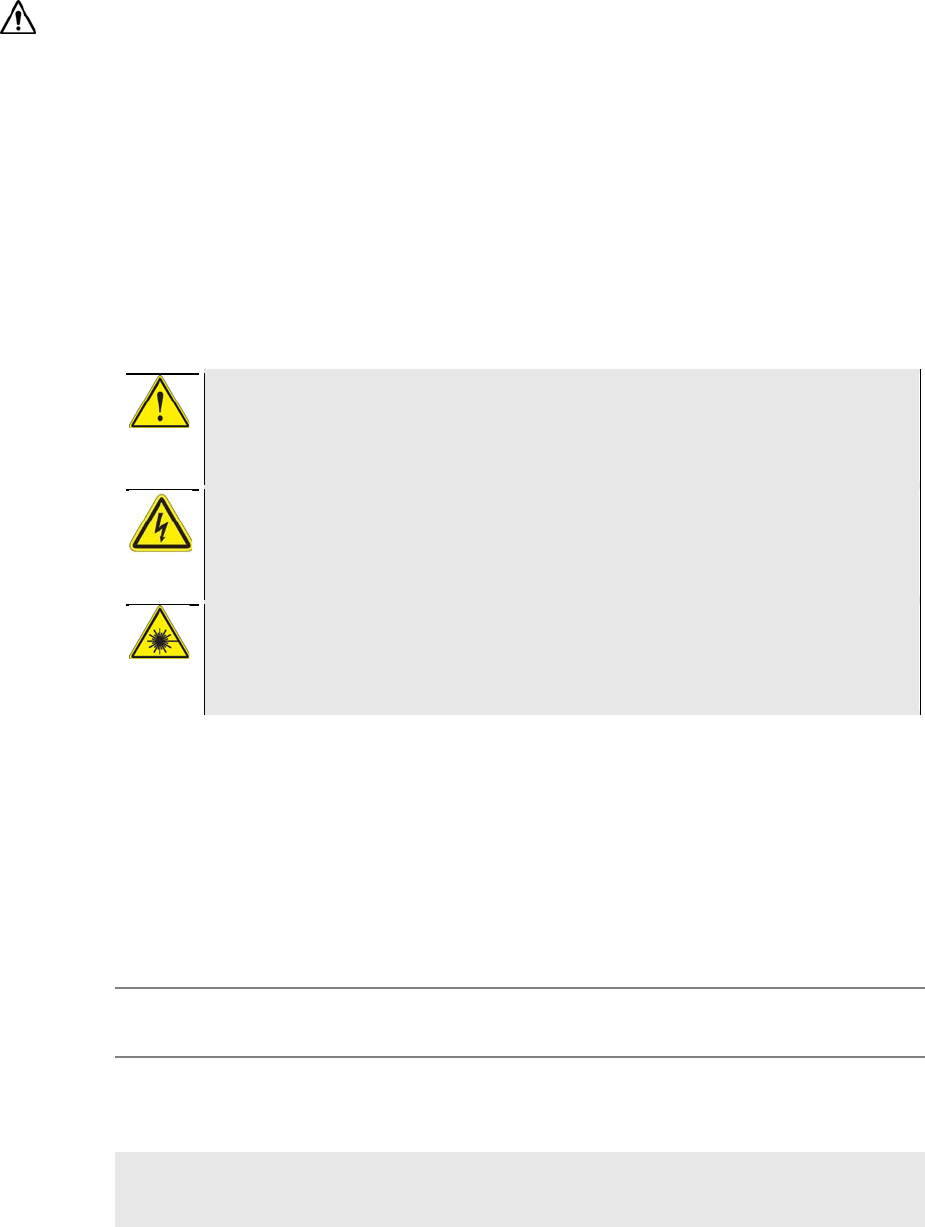
Importanti istruzioni di sicurezza
Safety Instructions: T-BERD/MTS 5800 Family, SC 4800 Family and TEM
2 March 2018 21148865, Rev 006 Page 11
Importanti istruzioni di sicurezza
Queste istruzioni forniscono una spiegazione dei simboli di sicurezza, le definizioni per i termini di
sicurezza e precauzioni da che seguire quando si utilizza le famiglie di prodotti T BERD ⁄ MTS 5800 e SC
4800, e la TEM.
Simboli di sicurezza
Sugli strumenti supportati da queste istruzioni vengono utilizzati i seguenti simboli di sicurezza. Tutte le
precauzioni di sicurezza devono essere osservate quando uso, la manutenzione o la riparazione degli
strumenti. In caso di mancato rispetto con le seguenti precauzioni di sicurezza o con pericoli, avvertenze e
precauzioni utilizzati nel presente documento o relativi manuali violi l'uso di questo strumento.
Questo simbolo rappresenta un pericolo generale. Può essere associata con un
messaggio di PERICOLO, AVVERTENZA, o ATTENZIONE. Vedere le condizioni di
sicurezza per ulteriori informazioni.
Questo simbolo rappresenta tensioni pericolose. Può essere associata con un
messaggio di PERICOLO, AVVERTENZA, o ATTENZIONE. Vedere le condizioni di
sicurezza per ulteriori informazioni.
Questo simbolo rappresenta un rischio connesso con i laser a fibra ottica. Può essere
associata con un messaggio di PERICOLO, AVVERTENZA, o ATTENZIONE. Vedere
le condizioni di sicurezza per ulteriori informazioni.
Definizioni di sicurezza
La Tabella 4 riporta le definizioni dei termini riguardanti la sicurezza utilizzati nella docu- mentazione dei
prodotti. La mancata osservanza di queste precauzioni durante l'utilizzo degli strumenti violi l'uso previsto
dei prodotti.
Tabella 4 Definizioni di sicurezza
Termine
Descrizione
PERICOLO
Indica una situazione di pericolo imminente che, se non evitata, provocherà
la morte o gravi lesioni.
AVVERTENZA
Indica una situazione di pericolo potenziale che, se non evitata, potrebbe
provocare la morte o gravi lesioni.
Importanti istruzioni di sicurezza
Safety Instructions: T-BERD/MTS 5800 Family, SC 4800 Family and TEM
2 March 2018 21148865, Rev 006 Page 12
Tabella 4 Definizioni di sicurezza
ATTENZIONE
Indica una situazione di pericolo potenziale che, se non evitata, potrebbe
provocare lesioni di lieve o moderata entità oppure danni all'attrezzatura.
Gli strumenti supportati da queste istruzioni sono progettati per essere utilizzati per testare non pericolosi
circuiti con tensioni inferiore a 42,4 V e 60 VDC.
Nelle linee esterne possono essere presenti tensioni pericolose provocate da colpi di fulmine o da
collegamenti accidentali con i circuiti di potenza. Tali linee sono classificate come circuiti di tensione delle
reti per telecomunicazioni (TNV, Telecommunications Network Voltage). I fornitori di telecomunicazioni
adottano tutte le opportune misure protettive per limitare pericolose sovracorrenti nelle linee TNV. È
tuttavia impossibile ottenere una protezione assoluta dai pericoli inerenti alla tensione TNV. La mancata
comprensione dei rischi legati alla tensione TNV (in particolar modo per quanto riguarda i lampi e il colle-
gamento accidentale a circuiti di alimentazione) può provocare gravi lesioni. L'utente è responsabile della
propria sicurezza ed è quindi tenuto ad adottare procedure idonee per ridurre al minimo il rischio di scosse
elettriche. Un addestramento completo in materia di sicurezza dei circuiti di tensione delle reti per
telecomunicazione (TNV) esula dagli scopi della presente guida. È però necessario che l'utente legga e
comprenda tutte le infor- mazioni relative alla sicurezza contenute nella presente guida prima di utilizzare il
prodotto.
Quando utilizza il prodotto, l'utente dovrà sempre adottare precauzioni di base per ridurre il rischio di
incendi, scosse elettriche e lesioni a terzi. Le precauzioni comprendono quanto riportato di seguito.
1. Leggere e osservare tutte le avvertenze e istruzioni riportate sul prodotto e contenute nel manuale.
2. ATTENZIONE: se l'impianto viene utilizzato in modo diverso da quello specificato da Viavi, ciò
potrebbe compromettere la protezione fornita.
3. Utilizzare esclusivamente l'adattatore AC/caricabatterie e cavi di rete forniti insieme al prodotto.
Non utilizzare l'adattatore AC/caricabatterie in esterni oppure in luoghi umidi o bagnati. Collegare
l'adattatore AC/caricabatterie alla tensione di rete corretta secondo quanto riportato sull'apposita
etichetta.
4. Non appoggiare alcun oggetto al cavo di alimentazione e non collocare il prodotto in punti in cui il
cavo potrebbe venir calpestato.
5. Questo prodotto è progettato per essere usato con cavo di alimentazione a tre fili che includa il
collegamento di terra (munito di spina con collegamento di terra). Questa modalità di collegamento
è vitale per operare in sicurezza con lo strumento. Non vanificare l'efficacia del collegamento di
terra modificandolo od utilizzando un colle- gamento diverso da quello fornito con lo strumento.
6. Non utilizzare l'apparecchio telefonico (tranne che nel caso di cordless) durante un temporale
elettrico. Esiste la possibilità di colpi di fulmine che superano la capacità dei dispositivi di
protezione della rete telefonica.
7. Non utilizzare l'impianto telefonico in prossimità di perdite di gas o in ambienti con esplosivi. In
condizioni di funzionamento normale, questo dispositivo di testing, e la maggior parte degli altri
apparecchi telefonici, possono generare scintille sufficienti a provocare fiamme o esplosioni.
8. Non toccare né entrare in altro modo in contatto con conduttori telefonici che possono essere stati
colpiti da fulmini o collegati accidentalmente a circuiti di potenza senza aver prima provveduto a
isolarli dalla rete telefonica.
Importanti istruzioni di sicurezza
Safety Instructions: T-BERD/MTS 5800 Family, SC 4800 Family and TEM
2 March 2018 21148865, Rev 006 Page 13
9. Non installare l'impianto o le terminazioni (jack) telefonici in luoghi umidi a meno che non siano stati
appositamente progettati per ubicazioni di tale tipo.
10. Non induca o che non lasci che il telefono o i circuiti di telecomunicazione contatti i circuiti di
alimentazione (condutture).
11. Non cercare di riparare da soli il prodotto; l'apertura o la rimozione dei coperchi potrebbero esporre
l'utente a tensione pericolosa e ad altri rischi. Rivolgersi a perso- nale qualificato per tutte le
operazioni di manutenzione.
12. Gli strumenti T-BERD / MTS 5800 (v1, v2, 100G, 5882) e SC 4800/4800P sono conformi ai limiti di
esposizione stabiliti per un ambiente non controllato da FCC e Industry Canada RF. Per un suo uso
vicino al corpo, gli strumenti soddisfano i limiti di esposizione FCC RF quando utilizzato con un
accessorio che non contiene metallo e che posiziona lo strumento un minimo di 0 centimetri dal
corpo. ATTENZIONE: Questo trasmettitore non deve essere co-locato o funzionare insieme ad
altre antenne o trasmettitori.
13. Usi i cavi adatti quando collegano ai circuiti di telecomunicazioni. Mettendo un connettore RJ-11 in
un orificio RJ-45 può danneggiare l'orificio RJ45.
14. AVVERTENZA: pericolo di estremo calore, incendio o esplosione in caso di manomis- sione della
batteria. Sostituisca soltanto con la batteria dello Li-IONE approvata Viavi. Smaltire le batterie
usate secondo le istruzioni della casa produttrice.
15. AVVERTENZA: Per ricaricare la batteria agli ioni di litio, utilizzare esclusivamente il caricabatterie
Viavi. La batteria va utilizzata esclusivamente con i prodotti Viavi.
16. L'uso di questo dispositivo di testing è riservato a tecnici delle telecomunicazioni opportunamente
addestrati in grado di comprendere i rischi associati ai circuiti TNV e di gestire in modo idoneo la
tensione TNV.
17. Verificare che i segnali TNV non siano collegati a porte SELV. Nel caso in cui sia necessario
accedere a una linea nella quale sono presenti tensioni TNV o alte tensioni di altro tipo utilizzando
una porta SELV, utilizzare un dispositivo di interfaccia omologato per la fornitura di un punto di
collegamento SELV.
18. Le interfacce compatibili con PoE classificate come SELV non sono destinate al collegamento a reti
PoE con instradamento verso l' impianto esterno.
19. ATTENZIONE: Se equipaggiato con moduli laser forniti da Viavi, questo strumento sarà un
prodotto LASER di classe 1. I laser di classe 1 possono causare dazzle, flash-cecità e immagini
residue. Evitare di guardare in uscita del laser durante l'esecuzione di operazioni critiche di
sicurezza, come arrampicata su una scaletta o di usare macchinari. Non utilizzare moduli laser di
altre classi.
20. Veda prego “Safety symbols” per i simboli di sicurezza. Dove l'unità è identificata con un simbolo
d'avvertimento, il operating manual deve essere consultato per imparare più circa la natura del
rischio potenziale e di tutta l'azione che devono essere intra- presi.
Conservare queste istruzioni
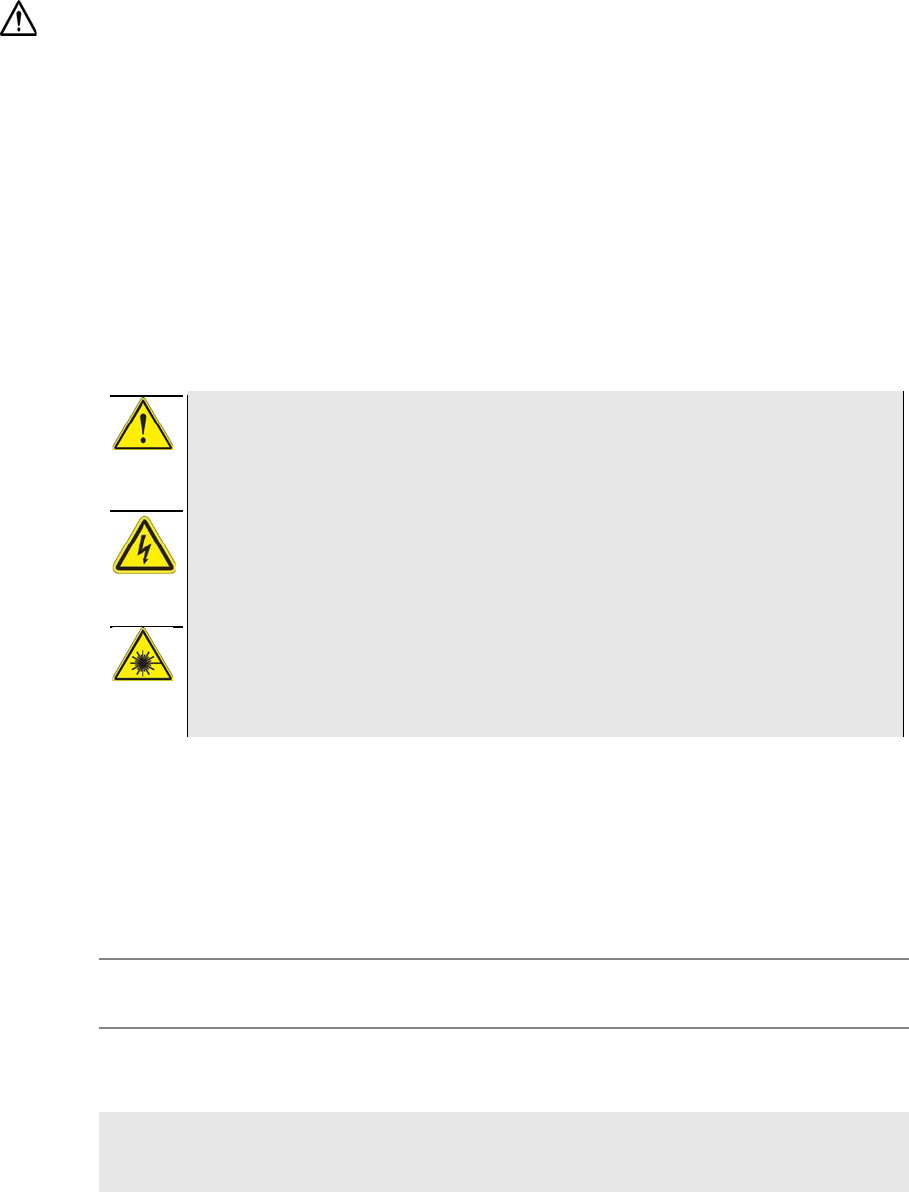
Instrucciones de seguridad
Safety Instructions: T-BERD/MTS 5800, SC 4800 and TEM
2 March 2018 21148865, Rev 005 Page 14
Instrucciones de seguridad
Estas instrucciones proporcionan una explicación de los símbolos de seguridad, definiciones de
términos de seguridad y precauciones que debe seguir al usar las familias de productos T-BERD ⁄ MTS
5800 y SC 4800, y el TEM.
Símbolos de seguridad
Se utilizan los siguientes símbolos de seguridad en los instrumentos de apoyo de estas instrucciones.
Deben observarse las precauciones de seguridad al funcionamiento, mantenimiento o reparación de
los instrumentos. No cumplir con las siguientes precauciones de seguridad o con peligros,
advertencias y precauciones se utiliza a lo largo de este documento o manuales relacionados con viola
el uso de este instrumento.
Este símbolo representa un peligro general. Puede estar asociada con un mensaje de
PELIGRO, ATENCIÓN o PRECAUCIÓN. Ver definiciones de seguridad para obtener
más información.
Este símbolo representa a voltajes peligrosos. Puede estar asociada con un mensaje
de PELIGRO, ATENCIÓN o PRECAUCIÓN. Ver definiciones de seguridad para
obtener más información.
Este símbolo representa un riesgo asociado con los láseres de fibra óptica. Puede
estar asociada con un mensaje de PELIGRO, ATENCIÓN o PRECAUCIÓN. Ver defini-
ciones de seguridad para obtener más información.
Definiciones de seguridad
La Table define los términos de seguridad empleados en la documentación del producto. La
inobservancia de estas precauciones viola las condiciones de uso de este producto.
Tabla 5 Definiciones de seguridad
Término
Descripción
PELIGRO Indica una situación peligrosa inminente que, si no se evita, puede resultar
mortal o causar lesiones graves.
ATENCIÓN Indica una situación potencialmente peligrosa que, si no se evita, puede
resultar mortal o causar lesiones graves.
Instrucciones de seguridad
Safety Instructions: T-BERD/MTS 5800 Family, SC 4800 Family and TEM
2 March 2018 21148865, Rev 006 Page 15
Tabla 5 Definiciones de seguridad
PRECAUCIÓN Indica una situación potencialmente peligrosa que, si no se evita, puede
causar lesiones leves o moderadas.
Los instrumentos de apoyo de estas instrucciones están diseñados para utilizarse para no peligrosos
circuitos con voltajes de prueba menos de 42,4 V pico y 60 VCC.
En las líneas tendidas al aire libre pueden existir tensiones peligrosas causadas por rayos o
conexiones accidentales a circuitos de alimentación. Tales líneas se denominan TNV (tensión de redes
telecomunicaciones). Los proveedores de telecomunicaciones utilizan todas las medidas de protección
razonables para limitar las sobretensiones en las líneas TNV. Sin embargo, no es posible lograr una
protección total contra descargas o conex- iones accidentales a fuentes de energía eléctrica. Puesto
que es imposible un diseño que posea una seguridad absoluta, el usuario debe responsabilizarse de
su propia seguridad y utilizar los procedimientos TNV adecuados para minimizar el riesgo de
descargas eléc- tricas. La explicación de los procedimientos de seguridad TNV es un tema que queda
fuera del ámbito de este folleto. Aún así, es importante que usted lea y comprenda toda la información
de seguridad antes de utilizar este equipo.
Cuando use este producto, observe en todo momento ciertas precauciones básicas para reducir el
peligro de incendios, golpes y lesiones personales, incluyendo:
1. Lea y observe todas las notas de seguridad indicadas en el producto, así como las incluidas en
este folleto y en la guía del usuario.
2. PRECAUCIÓN: Si este equipo se utiliza de forma distinta a lo especificado por Viavi, los
mecanismos de protección previstos pueden dejar de funcionar u operar inadecuadamente.
3. Utilice únicamente el adaptador de CA/cargador y los cables de alimentación suministrados con
el producto. No lo emplee en exteriores ni en lugares mojados o muy húmedos. Conecte el
adaptador/cargador de alterna a la tensión de red correcta, indicada en la etiqueta del
instrumento.
4. No aplaste el cable de alimentación. No coloque el instrumento de forma que alguien pueda
pisar accidentalmente el cable de alimentación.
5. Este producto está diseñado para ser utilizado con cable con conexión a tierra (cable con
banana/pin tierra). Esta protección es vital para la operación segura del equipo. No
obstaculicen el propósito de la conexión a tierra modificando el cable o utilizando un adaptador
6. Evite el uso de equipos telefónicos fijos durante las tormentas con aparato eléctrico. Cualquier
rayo caído en las proximidades podría exceder la capacidad de los dispos- itivos de protección
de la red telefónica y causar daños personales.
7. No utilice equipos telefónicos en las proximidades de lugares con pérdidas de gas o en
entornos relacionados con atmósferas explosivas. Este instrumento, como la mayoría de
equipos telefónicos, podría generar una chispa capaz de iniciar un incendio o provocar una
explosión.
8. No toque conductores telefónicos que pudieran estar expuestos a rayos o a conex- iones
accidentales con circuitos de alimentación, sin aislarlos previamente de la red telefónica.
9. No instale equipos telefónicos ni terminaciones (tomas de red) en lugares húmedos, a menos
que los equipos o terminaciones hayan sido diseñados específicamente para dichos lugares.
Instrucciones de seguridad
Safety Instructions: T-BERD/MTS 5800 Family, SC 4800 Family and TEM
2 March 2018 21148865, Rev 006 Page 16
10. No haga ni permita que el teléfono o los circuitos de telecomunicación venga en contacto con
los circuitos de la energía (cañerías).
11. No trate de reparar este producto. Al abrir o quitar las cubiertas pueden quedar al descubierto
elementos con tensiones elevadas. Consulte a un técnico de asistencia cualificado.
12. Los equipos T-BERD / MTS 5800 (v1, v2, 100G, 5882) y SC 4800 cumplen con los límites de
exposición establecidos para un ambiente incontrolado por la FCC y la Industry Canada RF.
Para la operación con el cuerpo, el instrumento cumple con los límites de exposición cuando es
utilizado con un accesorio que no contiene metal y que posiciona al instrumento a una distancia
mínima de 0cm del cuerpo. PRECAUCIÓN: Este transmisor no debe colocarse ni funcionar en
conjunto con alguna otra antena o transmisor.
13. Utilice los cables apropiados al conectar con los circuitos de telecomunicaciones. Poner un
conectador RJ-11 en un puerto RJ-45 puede dañar el puerto RJ45.
14. ATENCIÓN: Existe riesgo de incendio o explosión si se sustituye la batería por una batería no
adecuada. Substituya solamente por la batería aprobada Viavi del Li ION. Para desechar las
baterías siga las instrucciones del fabricante.
15. ATENCIÓN: Para cargar la batería litio-ion, utilice sólo el instrumento Viavi o el cargador
recomendado por Viavi. La batería debe usarse exclusivamente en equipos de Viavi.
16. Este instrumento debe ser utilizado por técnicos experimentados que conozcan los riesgos
asociados a las líneas TNV y empleen los procedimientos de seguridad apropiados.
17. Las señales TNV no deben conectarse a los puertos SELV. Si necesita acceder con un puerto
SELV a una línea que pueda tener tensiones TNV o superiores, use un dispositivo de interfaz
capaz de proporcionar un puerto SELV.
18. Las interfaces compatibles con PoE que se clasifican como SELV no están diseñadas para la
conexión a redes PoE con enrutamiento a la planta exterior.
19. PRECAUCIÓN: Si está equipado con módulos láser suministrados por Viavi, este instrumento
será un PRODUCTO del laser de la CLASE 1. Láseres de clase 1 pueden causar
deslumbramiento, flash-ceguera y retina. Evite mirar a salida del laser mientras que realiza las
operaciones críticas de seguridad, tales como subir a una escalera o manejar maquinaria. No
utilice módulos láser de otras clases.
20. Vea por favor los “Safety symbols” para los símbolos de seguridad. Donde la unidad se etiqueta
con un símbolo amonestador, el operating manual se debe consultar para aprender más sobre
la naturaleza del peligro potencial y de cualquier acción que deban ser tomados.
Guarde estas instrucciones
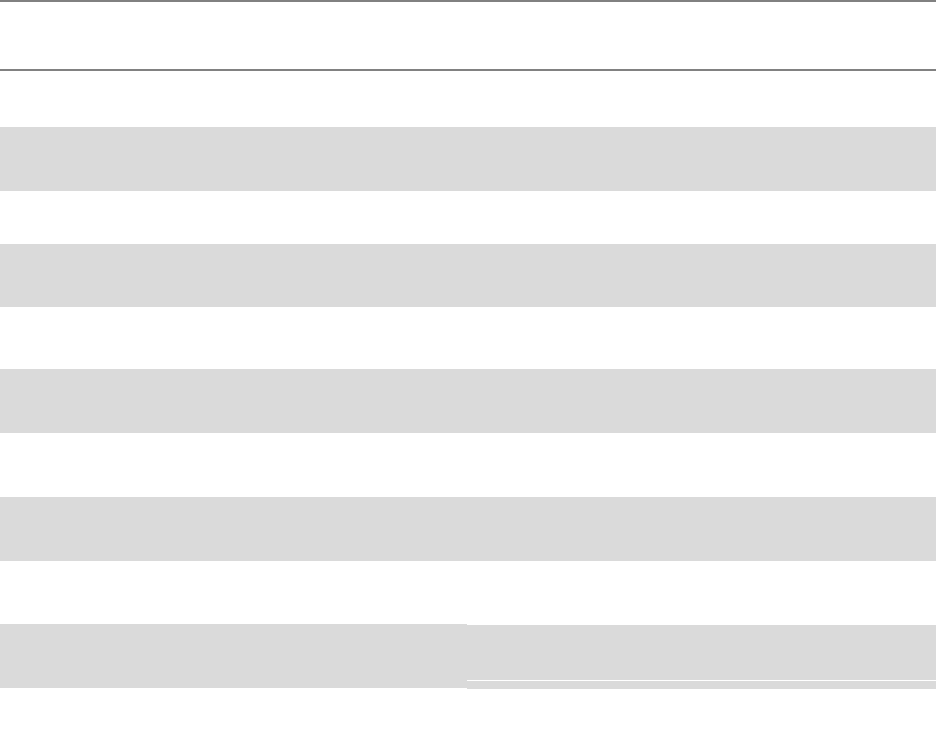
Safety Classifications and Standards
Safety Instructions: T-BERD/MTS 5800 Family, SC 4800 Family and TEM
2 March 2018 21148865, Rev 006 Page 17
Safety Classifications and Standards
The following sections provide interfaces, safety classifications, and safety standards for the T-BERD ⁄
MTS 5800 (v1, v2, 100G, 5882 and the accessories, 5800-TOD and 5800-EPP), SC 4800 (4800,
4800P) and the TEM.
Interfaces and Safety Classifications
Table 6 lists the T-BERD ⁄ MTS 5800v1 interfaces, port designations, safety classifications, and
maximum working voltage for each port.
Table 6
T-BERD ⁄ MTS 5800v1
Interface Port Designation Safety Classification Working Voltage
DS1 Rx1, Tx/Rx2 Hazardous Voltage 300VDC
E3/DS3/E4/STS-1/STM-1e Rx1, Tx/Rx2 SELV ± 1 V Unbalanced
DS1/E1 Tx/Rx2/Rx1 120Ω SELV 6 Vpp
Ethernet 10/100/1000 SELV 48 V DC ± 5 V balanced
SFP SFP Class 1 laser -------
XFP XFP Class 1 laser -------
Clock EXT CLK SELV 5 V
Headset Headset SELV 5 V
USB USB SELV 5 V
Power 12V SELV 12 V
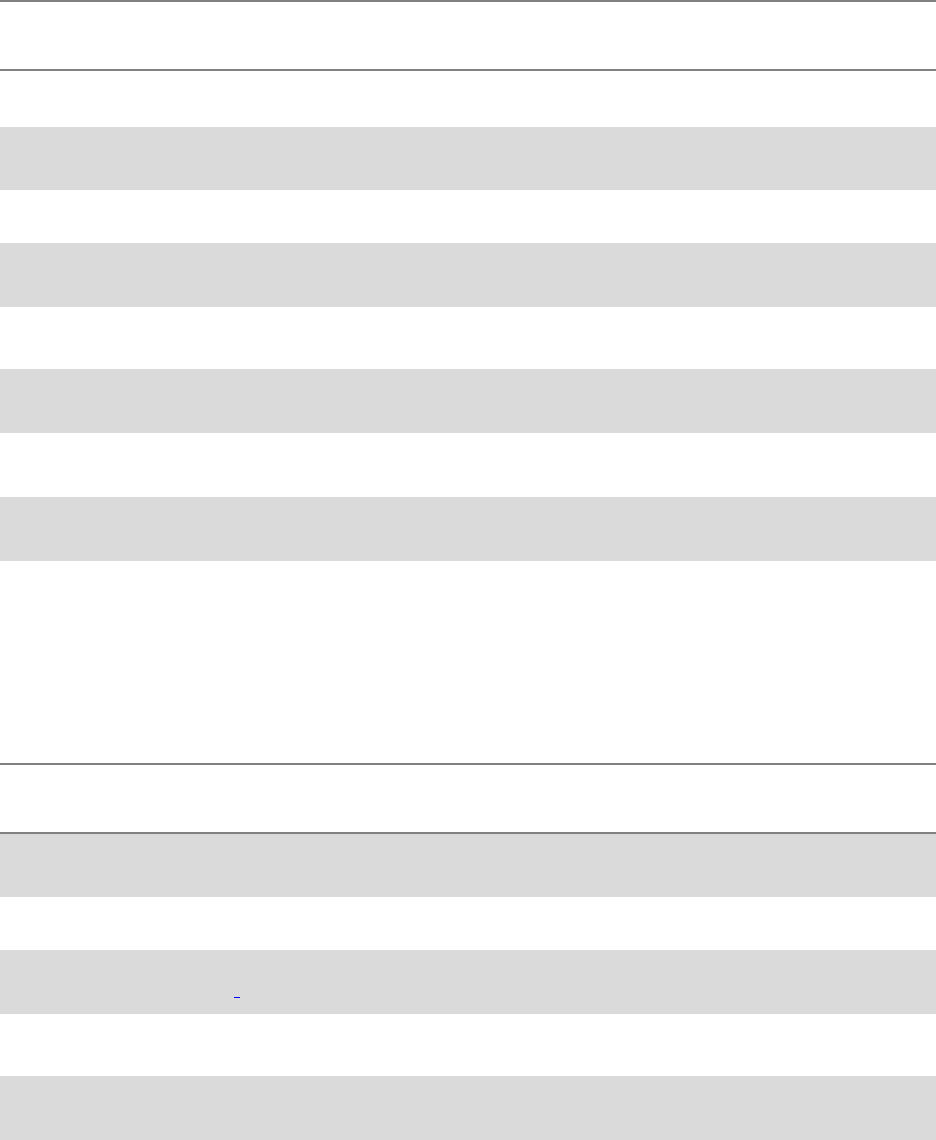
Safety Classifications and Standards
Safety Instructions: T-BERD/MTS 5800 Family, SC 4800 Family and TEM
2 March 2018 21148865, Rev 006 Page 18
Table 7 lists the T-BERD ⁄ MTS 5800v2 interfaces, port designations, safety classifications, and
maximum working voltage for each port.
Table 7 T-BERD ⁄ MTS 5800v2
Interface
Port Designation
Safety Classification
Working Voltage
DS1
Rx1, Tx/Rx2
SELV
7.2Vpp
E3/DS3/E4/STS-1/STM-1e Rx1, Tx/Rx2 SELV ± 1 V Unbalanced
DS1/E1
DS1/E1 120Ω
SELV
6 Vpp
Ethernet 10/100/1000 SELV 48 V DC ± 5 V balanced
SFP+ SFP+ Class 1 laser -------
Clock EXT CLK SELV 5 V
Headset Headset SELV 5 V
USB USB SELV 5 V
Power 12V SELV 12 V
Table 8 lists the T-BERD ⁄ MTS 5882 interfaces, port designations, safety classifications, and maximum
working voltage for each port.
Table 8 T-BERD ⁄ MTS 5882
Interface
Port Designation
Safety Classification
Working Voltage
E3/DS3/E4/STS-1/STM-1e RX1, TX/RX2 SELV ± 1 V Unbalanced
DS1/E1
DS1/E1 120Ω
SELV
6 Vpp
Ethernet
(Port 2 is PoE-compatible)
1
10/100/1000 SELV 57 V DC ± 5 V balanced
SFP+ SFP+ Class 1 laser -------
Clock EXT CLK REF SELV 5 V
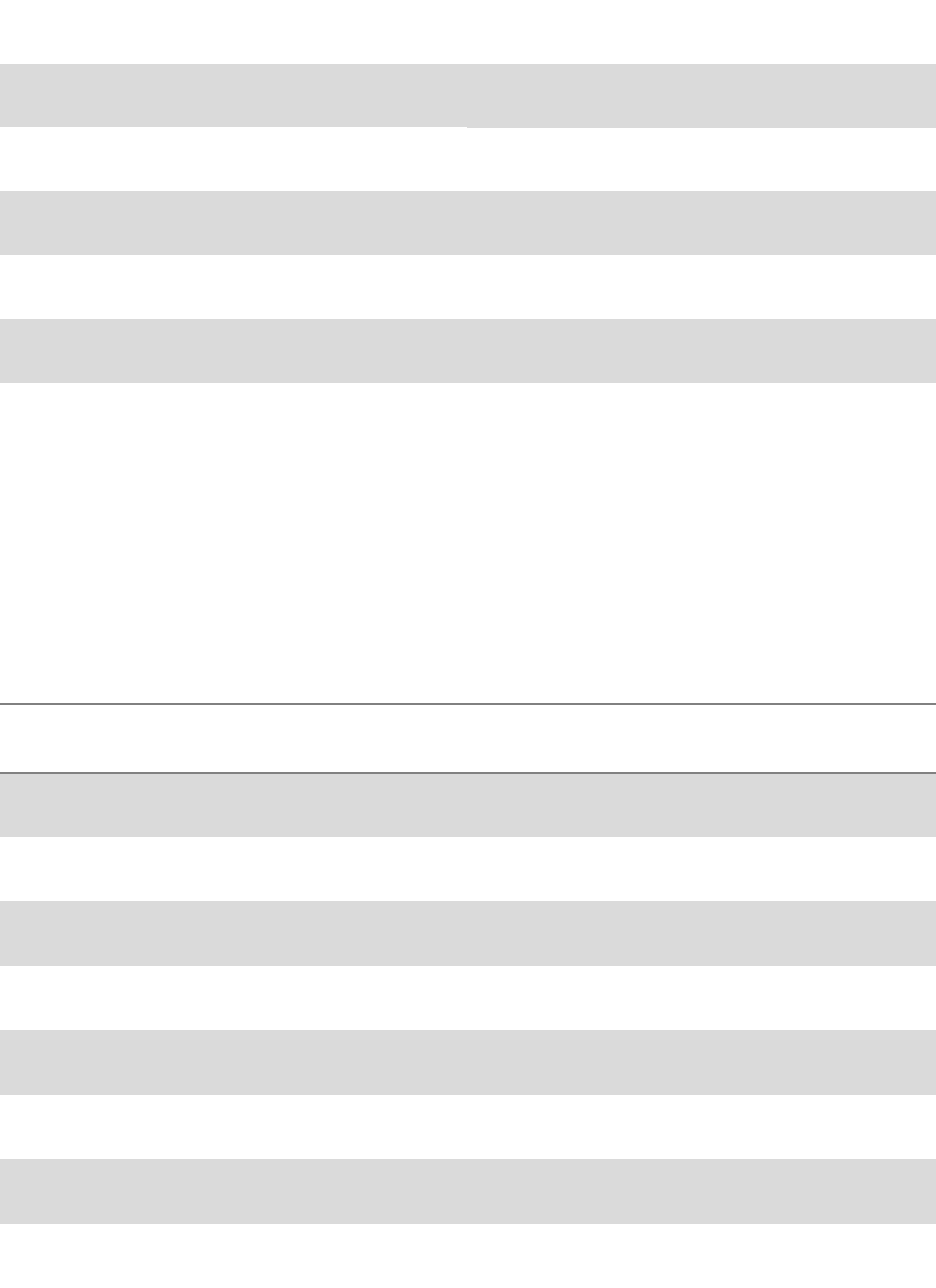
Safety Classifications and Standards
Safety Instructions: T-BERD/MTS 5800 Family, SC 4800 Family and TEM
2 March 2018 21148865, Rev 006 Page 19
Headset Headset SELV 5 V
USB USB SELV 5 V
Power 19V SELV 19 V
GNSS Antenna GNSS ANTENNA SELV 5 V
CLK IN/OUT CLK IN/OUT SELV 5 V
1PPS IN 1PPS IN SELV 5 V
1PPS IN REF 1PPS IN REF SELV 5 V
1: Port 2 is PoE-compatible in terms of traffic generation and power capability determination of connected PSE. The instrument does not provide or
consume line power as a PSE or PD. Also, the instrument is not intended for connection to PoE networks with routing to the outside plant.
Table 9 lists the T-BERD ⁄ MTS 5800-100G interfaces, port designations, safety classifications, and
maximum working voltage for each port.
Table 9
T-BERD ⁄ MTS 5800-100G
Interface Port Designation Safety Classification Working Voltage
E3/DS3/E4/STS-1/STM-1e RX1, TX/RX2 SELV ± 1 V Unbalanced
DS1/E1
DS1/E1 120Ω
SELV
6 Vpp
Ethernet 10/100/1000 SELV 48 V DC ± 5 V balanced
SFP+/SFP28 SFP+/SFP28 Class 1 laser -------
Clock EXT CLK REF SELV 5 V
Headset Headset SELV 5 V
USB USB SELV 5 V
Power 19V SELV 19 V
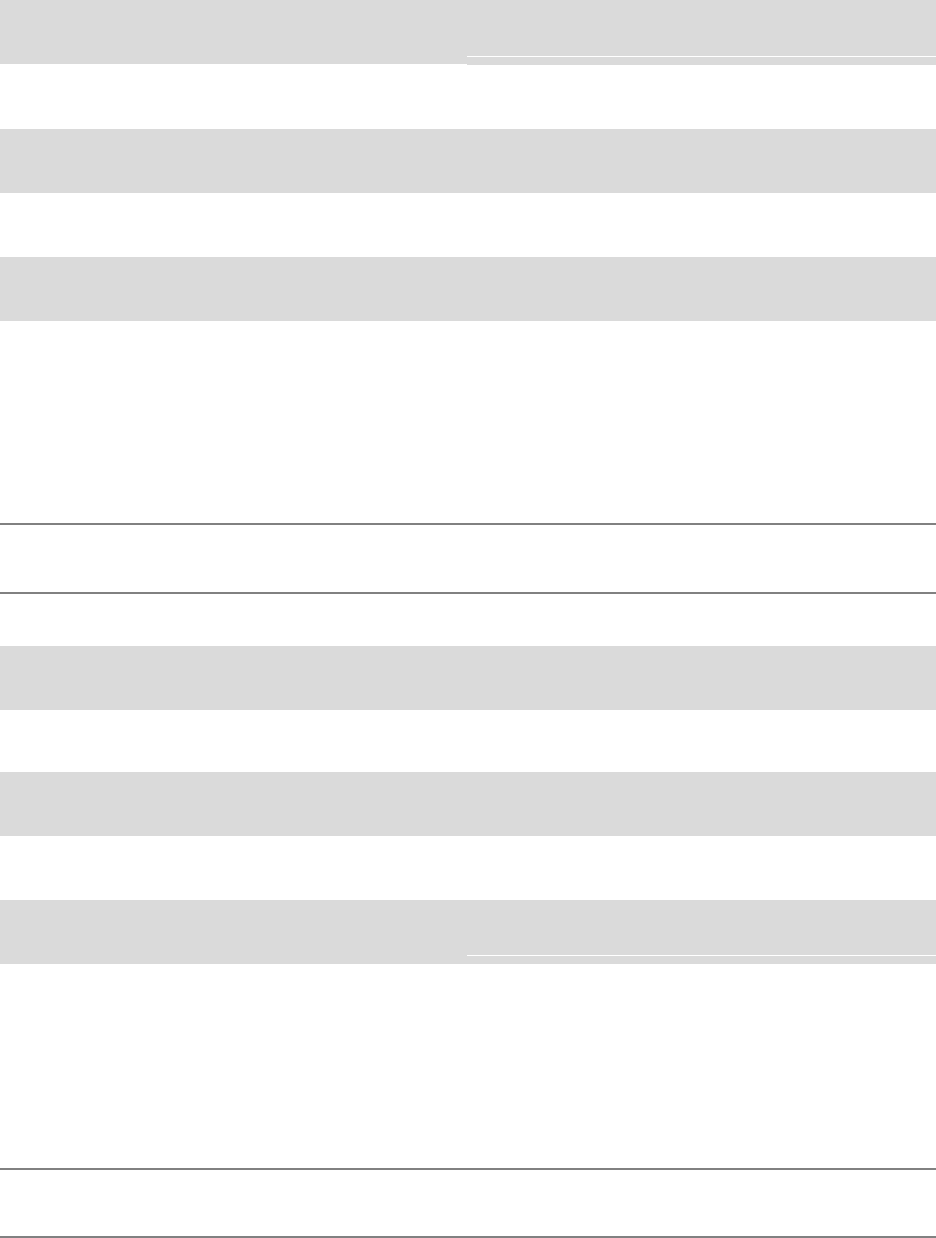
Safety Classifications and Standards
Safety Instructions: T-BERD/MTS 5800 Family, SC 4800 Family and TEM
2 March 2018 21148865, Rev 006 Page 20
QSFP+/QSFP28 QSFP+/QSFP28 Class 1 laser -------
CFP4 CFP4 Class 1 laser -------
GNSS Antenna GNSS Antenna SELV 5 V
CLK IN/OUT CLK IN/OUT SELV 5 V
1PPS IN REF 1PPS IN REF SELV 5 V
Table 10 lists the SC 4800/4800P interfaces, port designations, safety classifications, and maximum
working voltage for each port.
Table 10
SC 4800/4800P
Interface Port Designation Safety Classification Working Voltage
DS1/E1
DS1/E1 120Ω
SELV
6 Vpp
Ethernet 10/100/1000 SELV 48 V DC ± 5 V balanced
SFP+ SFP+ Class 1 laser -------
Headset Headset SELV 5 V
USB USB SELV 5 V
Power 12V SELV 12 V
Table 11 lists the TEM interfaces, port designations, safety classifications, and maximum working
voltage for each port.
Table 11 TEM
Interface Port Designation Safety Classification Working Voltage
1PPS IN1
1PPS IN1
SELV
5 V
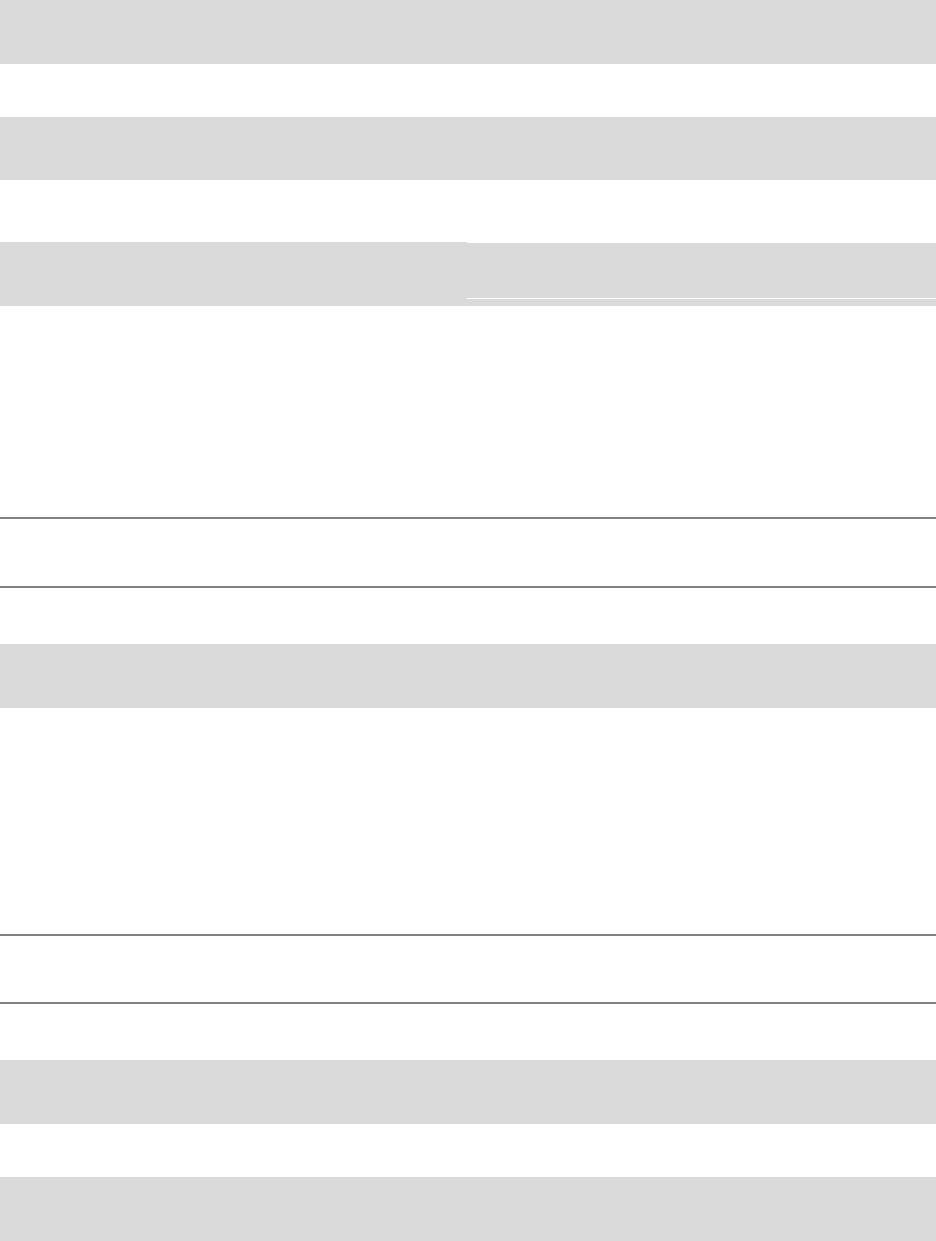
Safety Classifications and Standards
Safety Instructions: T-BERD/MTS 5800 Family, SC 4800 Family and TEM
2 March 2018 21148865, Rev 006 Page 21
1PPS IN2 1PPS IN2 SELV 5 V
1PPS OUT
1PPS OUT
SELV
3.3 V
10MHz OUT 10MHz OUT SELV 3 V
10MHz REF IN 10MHz REF IN SELV 5 V
GNSS ANTENNA GNSS ANTENNA SELV 5 V
Table 12 lists the T-BERD ⁄ MTS 5800-EPP interfaces, port designations, safety
classifications, and maximum working voltage for each port.
Table 12 T-BERD/MTS 5800-EPP
Interface Port Designation Safety Classification Working Voltage
Power
1PPS IN1
SELV
5 V
Shield Ground Continuity 1PPS IN2 SELV 5 V
Wire-map
1PPS OUT
SELV
3.3 V
Table 13 lists the T-BERD ⁄ MTS 5800-TOD interfaces, port designations, safety classifications,
and maximum working voltage for each port.
Table 13 T-BERD/MTS 5800-TOD
Interface Port Designation Safety Classification Working Voltage
Power/ToD
+5VDC
SELV
5 V
ToD/1 PPS In ToD/1 PPS In SELV 6 V DC ± 10 V balanced
1PPS OUT
1PPS OUT
SELV
5 V
1 PPS In 1 PPS In SELV 5 V
Safety Classifications and Standards
Safety Instructions: T-BERD/MTS 5800 Family, SC 4800 Family and TEM
2 March 2018 21148865, Rev 006 Page 22
Safety Standards
This section lists the safety standards that apply to the T-BERD ⁄ MTS 5800 (v1, v2, 100G, 5882), SC
4800/4800P and the TEM.
The T-BERD ⁄ MTS 5800 (v2, 100G, 5882 and the accessories, 5800-TOD and 5800-EPP), SC
4800/4800P and the TEM meet the following standards:
• UL 61010 -1/ CSA C22.2 No. 61010-1, Electrical Equipment For Measurement, Control, and
Laboratory Use; 3rd edition, Rev 5/11/2012
• EN 61010-1/ IEC 61010-1:2010, Safety requirements for electrical equipment for Measurement,
Control, and Laboratory Use; Part 1, Rev 10/1/2010
The T-BERD ⁄ MTS 5800v1 meets the following standards:
• UL 61010 -1/ CSA C22.2 No. 61010-1, Electrical Equipment For Measurement, Control, and
Laboratory Use; 2nd edition, Rev 10/28/2008
• EN 61010-1/ IEC 61010-1:2001, Safety requirements for electrical equipment for Measurement,
Control, and Laboratory Use; Part 1, Rev 9/18/2003
• TNV circuit was evaluated to UL60950-1/CSA C22 No 60950-1, Safety for information
technology equipment, 2nd edition, Rev 03/27/2007

T-BERD / MTS 5800, SC 4800 and TEM Safety Classifications and Standards
Viavi Solutions
1-844-GO-VIAVI
www.viavisolutions.com
© Copyright August 2017 Viavi Solutions Inc.. All rights reserved. Copyright release: Reproduction and
distribution of this guide is authorized for US Government purposes only. All other trademarks and registered
trademarks are the property of their respective owners. Specifications, terms, and conditions are subject to
change without notice.